
The British Museum is one of the oldest public museums in the world, established in 1753. Today the British Museum’s collection includes over eight million objects housed in ninety-four different Galleries.
It is a museum where every visit brings something new. “Joy of Museums” covers the key highlights of the British Museum and provides background information to help you to appreciate its many mysteries & treasures.
A Virtual Tour of the British Museum
Ancient Egypt and Sudan Collection
- The Rosetta Stone
- The Battlefield Palette 3100 BC
- Quartzite Head of the Egyptian Pharaoh Amenhotep III
- Colossal Granite Statue of Amenhotep III
- Hunters Palette
- Tomb of Nebamun
- Younger Memnon (Ramesses II)
- Book of the Dead – Papyrus of Ani and Hunefe
- Mummy of Katebet
Middle East Collection
- The Lion Hunt
- Cyrus Cylinder
- Royal Game of Ur
- Gilgamesh Flood Tablet
- Stela of Shamshi-Adad V
- Standard of Ur
- Ram in a Thicket
- Tell al-‘Ubaid Copper Lintel
- Assyrian Sacred Tree – Wall Panel Relief
- Babylonian Map of the World Tablet
- Complaint Tablet To Ea-Nasir
Ancient Greece and Rome Collection
- Marble figure of a Woman – Spedos Type
- The Parthenon Marbles
- The Parthenon Frieze
- Metopes of the Parthenon
- Pedimental Sculptures of the Parthenon
- The Erechtheion Caryatid
- Lion from the Mausoleum at Halicarnassus
- Bust of Pericles
- Aegina Treasure
- Townley Caryatid
- Bronze Statue of a Youth
- Thalia, Muse of Comedy
- Nereid Monument
- Sarcophagus of Seianti Hanunia Tlesnasa
- Lely Venus – Crouching Aphrodite
- Tomb of Payava
- Marble Portrait Bust of the Blind Poet Homer
- “Boy with Thorn” or “Spinario”
- Townley Discobolus
- Portland Vase
- The Knucklebone Player
Britain, Europe, and Prehistory Collection
- Ain Sakhri Lovers
- Wolverine Pendant of Les Eyzies – Prehistoric Portable Art
- Antler Perforated Baton – Paleolithic Portable Art
- Prehistoric Petrosphere – Carved Stone Spheres and Balls
- The Sutton Hoo Ship Burial
- Lewis Chessmen
- Holy Thorn Reliquary
- Mechanical Galleon
- Black St George Icon
- Knight Aquamanile
- Gold Mold Cape
- Battersea Shield
- Mildenhall Treasure – Great Plate of Bacchus
- Lindow Man
- Bronze Age Gold Lunula
- Bronze Age Shield Yetholm-type -1200 – 800 BC
Asian Collection
- Seated Buddha from Gandhara
- Statue of Tara
- Bodhisattva Avalokiteshvara
- Avalokiteshvara – Guanyin
- Nandi – Figure of the Humped Bull of Śiva
- Garuda
- Budai Hesheng
- Luohan – Yixian Glazed Ceramic Sculpture
Africa, Oceania and the Americas Collection
- Double-Headed Serpent
- Hoa Hakananai’a / Moai from Easter Island
- Hawaiian Feathered Helmet
- Bronze Head from Ife
- Benin Ivory Mask
The Prints and Drawings Collection
- “Studies of a Reclining Male Nude” by Michelangelo
- Newport Castle by J. M. W. Turner
- “Hampstead Heath” by John Constable
- “The Great Wave off Kanagawa” by Katsushika Hokusai
- “Rainstorm Beneath the Summit” by Katsushika Hokusai
Information on The British Museum
- Masterpieces of the British Museum
Highlights Tour of the British Museum
Ancient Egypt and Sudan Collection
The Rosetta Stone
The stone is valuable because it is inscribed with three versions of a decree issued at Memphis, Egypt, in 196 BC. The top text is in Ancient Egyptian using the hieroglyphic script, the middle passage is Ancient Egyptian Demotic script, and the bottom is in Ancient Greek.
As the decree is the same in all three versions, the Rosetta Stone provided the key to decipher Egyptian hieroglyphs.
The Battlefield Palette 3100 BC
This Battlefield Palette may be the earliest battle scene representation from Ancient Egypt. Created before Egypt was united as one state under one pharaoh, a regional ruler commissioned this decorated palette to increase their influence.
It was intended for display in early rituals related to power. The Battlefield Palette depicts the aftermath of a great battle.
A lion devours a prisoner and vultures attack bound individuals and corpses. In the top left, two captives are tied to ceremonial standards topped with images that may represent gods.
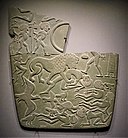
Quartzite Head of the Egyptian Pharaoh Amenhotep III
This Quartzite head of Amenhotep III has been carved with expert care. The eyeballs noticeably angled back from the top to the bottom lid so that they appear to look down at the viewer.
The finishing polish was deliberately varied, from a glittering smoothness on the facial surfaces to less finish on the mouth and eyes, to quite rough surfaces on the brows. Amenhotep is shown with youthful-looking cheeks, broad, long, and somewhat narrow eyes and the lower lip, which curves up to the open corners of the mouth, to produce the effect of a slight smile.
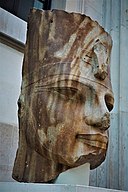
Colossal Granite Statue of Amenhotep III
This enormous red granite statue of Amenhotep III depicts the Ancient Egyptian Pharaoh Amenhotep III, wearing the double crown of Upper and Lower Egypt.
This massive large fragment was created in 1370 BC, was found in the temple enclosure of Mut at Karnak in Egypt. The statue is made of red granite, and only the head and an arm are known to survive.

Hunters Palette
The Hunters Palette or Lion Hunt Palette is a 5,000-year-old cosmetic palette that is among the few objects that feature the earliest Egyptian bas-reliefs from the late predynastic period of Naqada III.
The Hunters Palette is decorated on one side only with scenes in low relief showing iconography of lion hunting as well as the hunting of other animals such as birds, desert hares, and gazelles.
Three men carry the standards denoting different tribes or provinces, and the other men carry weapons, which include the bow, spear, mace, throw-stick, and a rope used for tethering.
Two iconographic conjoined bull-forefronts adorn the upper right alongside a hieroglyphic symbol.

Tomb of Nebamun
The Tomb of Nebamun is the source of some of the most famous ancient Egyptian polychrome tomb-painting scenes. This scene depicts Nebamun standing on a small boat, fishing and fowling in the marshes of the Nile with fish shown beneath the water-line.
His wife stands behind him, portrayed on a smaller scale, and his daughter sits beneath him, holding one of his legs.
Nebamun holds a throw-stick in one hand and decoy herons in the other. His cat is shown catching three birds, and many other birds are depicted flying away after being startled from the papyrus-thicket.
This Tomb-Painting is one of the most significant paintings from ancient Egypt to have survived.

Younger Memnon (Ramesses II)
Younger Memnon is an Ancient Egyptian statue, one of two colossal granite heads from the Ramesseum mortuary temple in Thebes. It depicts Pharaoh Ramesses II wearing the Nemes head-dress with a cobra diadem on top.
The damaged statue is one of a pair that initially flanked the Ramesseum’s doorway. The head of the other figure can be seen at the Ramesseum temple near Luxor.
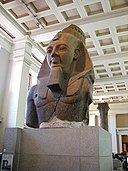
Book of the Dead – Papyrus of Ani and Hunefe
The “Book of the Dead” is an ancient Egyptian funerary manuscript written on papyrus consisting of magic spells intended to assist a dead person’s journey through the underworld, and into the afterlife.
The original Egyptian name for the text is translated as “Book of Coming Forth into the Light.” It was placed in the coffin or burial chamber of the deceased.
The texts and images in the “Book of the Dead” evolved from the writings of many priests over about 1,000 years. They were used from the beginning of the New Kingdom around 1550 BCE to around 50 BCE.

The Middle East Collection
The Lion Hunt
“The Lion Hunt” is a low relief sculpture showing the Royal Lion Hunt of King Ashurbanipal with his royal entourage, together with horses, dogs on leashes, and chariots.
The sculpture shows captured lions and lionesses being released from cages to do battle with the King. The Lion Hunt is one of the most captivating works of art from antiquity.

Cyrus Cylinder
The Cyrus Cylinder is an ancient clay cylinder, from the 6th century BC, on which is written a declaration in cuneiform script in the name of Persia’s King Cyrus the Great.
It describes the king’s capture of Babylon in 539 BC and how he restored temples in major cities and returned deported people to their homes.
The text on the Cylinder praises Cyrus for his peaceful and just rule, and due to these precepts, this historical object has been claimed to be an early version of ‘charter of human right.’

Royal Game of Ur
The Royal Game of Ur is an ancient game represented by two game boards found in the Royal Tombs of Ur in Iraq and date from before 2600 BC.
The rules of the game, are known based on the discovery of clay cuneiform tablets from Babylonian dating from 177–176 BC. The rules show that it was a form of a racing game similar to and an early predecessor to the present-day backgammon.
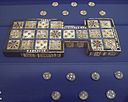
Gilgamesh Flood Tablet
The Gilgamesh Flood Tablet contains the flood story from the Epic of Gilgamesh, which is an epic poem from ancient Mesopotamia that is often regarded as the earliest surviving great work of literature.
The flood story was added to the Gilgamesh Epic utilized surviving Babylonian deluge stories from older Sumerian poems which inspired the flood myth.

Stela of Shamshi-Adad V
The Stela of Shamshi-Adad V is a massive round-topped white limestone monolith that portrays the Assyrian King worshipping his gods.
The monarch is shown wearing a conical hat, and full beard with his right hand extended snapping his fingers and his left hand holding a mace, his symbol of royal authority.
A significant amount of cuneiform text covers the sides of the stela, recording the king’s military campaigns,
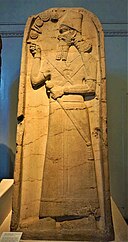
Assyrian Sacred Tree – Wall Panel Relief
This gypsum wall panel relief is filled with Assyrian symbolism, and at its center is depicted the Tree of Life or the Assyrian Sacred Tree.
King Ashurnasirpal appears twice, dressed in ritual robes and holding the mace symbolizing his authority. The King stands in front of a Sacred Tree, possibly symbolizing life. Protective spirits are shown on either side behind the King.
King Ashurnasirpal is making gestures of worship to a god in a winged disc. The god, who may be the sun god Shamash, has a ring on one hand; this is an ancient symbol of god-given kingship.

Ancient Greece and Rome Collection
Marble figure of a Woman – Spedos Type
This Cycladic figurine is a female figure with an elongated slender form with folded arms. This marble sculpture is a fabulous creation of the Cycladic Culture and was probably associated with ancient Aegean religious beliefs.
The marble figure has a flat profile with broad shoulders, the breasts are in relatively higher relief, and the abdomen is slightly protuberant.
The legs are more rounded and separated by a deep groove. The head is of the usual Cycladic type, bent back and thin, with a long narrow nose. This figurine is slightly damaged with the feet broken away, and the head has been reconnected.

The Parthenon Marbles
The Parthenon was built on the Acropolis of Athens, Greece, between 447 and 432 B.C. It was a testament to the glory and pride of the Athenian state. The Parthenon stands on the Acropolis of Athens, which in ancient times, as it does today, dominates the city of Athens.
The Acropolis is an extremely rocky outcrop above the city of Athens. The word acropolis comes from the Greek, Akron, meaning “highest point” and polis meaning “city.”
The Acropolis is a flat-topped rock that rises high over Athens, with a large flat area that has been used as a fortress and a religious center from time immemorial.
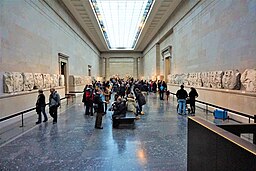
The Parthenon Frieze
The Parthenon frieze is the high-relief marble sculpture created to adorn the upper part of the Parthenon’s inner chamber of the temple. It was sculpted about 440 BC, and of the 160 m (524 ft) of the original frieze, about 80 percent survive today.
The rest is known only from the drawings made in 1674 before the Venetian bombardment ruined the temple. The frieze depicts the Panathenaic procession of the citizens of Athens to the Acropolis.
In this annual procession at which Athenians and foreigners participated to honor Athena by offering sacrifices and a new peplos, a dress woven by selected noble Athenian girls.
The grand parade shows a thanksgiving sacrifice of cattle and sheep, honey, and water, followed by the victorious army celebrating their victories.
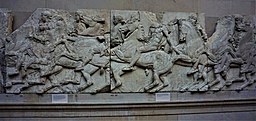
Metopes of the Parthenon
The “Metopes of the Parthenon” are the surviving set of what initially had been 92 square carved plaques of marble initially located above the columns of the Parthenon on the Acropolis of Athens.
Typically each metope depicts two characters in combat. The Metopes were part of the relief sculptures that were integral to the architecture of the Parthenon. They are square marble blocks that were positioned high on the exterior of the temple walls.

Pedimental Sculptures of the Parthenon
The Pediments of the Parthenon are the two sets of fifty statues in marble initially located on the east and west facades of the Parthenon on the Acropolis of Athens.
The East Pediment, which was above the entrance to the temple, told the story of the birth of Athena from the head of her father, Zeus. The sculptural arrangement depicts the moment of Athena’s birth.
The West Pediment illustrated the contest between Athena and Poseidon during their competition for the honor of becoming Athens’ patron.
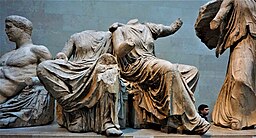
The Erechtheion Caryatid
- This marble, Caryatid is a sculpted female figure that was initially part of the Erechtheion, which is an ancient Greek temple on the Acropolis of Athens in Greece.
- This Caryatid is one of six female figures that supported the architrave on the south porch of the Erechtheion. The woman wears a peplos pinned on each shoulder.
- A peplos is a body-length garment that was the typical attire for women in ancient Greece. Her hair is braided and falls down her back.
- The body weight is depicted as taken on the right leg, hidden by vertical folds of the garment, and the other leg is bent.

Lion from the Mausoleum at Halicarnassus
This lion is among the few free-standing sculptures remaining from the Mausoleum at Halicarnassus, which was one of the Seven Wonders of the Ancient World.
The Mausoleum was a massive structure designed by Greek architects during the Classical Greek period.
The Mausoleum at Halicarnassus or Tomb of Mausolus was a tomb built between 353 and 350 BC, which was located at present-day Bodrum, Turkey. The Tomb was built for Mausolus, the ruler of Halicarnassus and his wife.

Bust of Pericles
This marble portrait bust is of Pericles wearing a military helmet pushed back on his head. Pericles (495 – 429 BC) was a prominent and influential Greek statesman, a famous orator, and the general of Athens during their Golden Age.
Pericles’s time as the leader of Athens has been called the “Age of Pericles,” as he substantially promoted the arts and literature.
Through his efforts, Athens achieved its reputation as the educational and cultural center of the ancient Greek world.
He started the ambitious projects that generated most of the surviving structures on the Acropolis, including the Parthenon. These projects beautified the city and exhibited its glory.
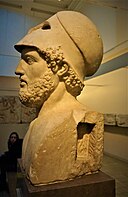
Aegina Treasure
The Aegina Treasure or Aigina Treasure is an important Minoan gold hoard found on the island of Aegina, Greece. The Minoan civilization was an Aegean Bronze Age civilization on the island of Crete and other Aegean islands, which flourished from about 2600 to 1100 BC.
The treasure was discovered in a tomb on the island of Aegina in 1891. Unfortunately, the exact circumstances have never been determined.

Townley Caryatid
This Townley Caryatid depicts a woman with cereal motifs on her modius headdress, which is dressed to take part in religious rites, possibly fertility rites related to Demeter or Ceres.
In ancient Greek religion and mythology, Demeter is the goddess of the harvest and agriculture, who presided over grains and the fertility of the earth. In ancient Roman religion, Ceres was a goddess of agriculture, grain crops, fertility, and motherly relationships.
Bronze Statue of a Youth
This bronze statue of a young man is a Roman version of an earlier Greek figure made of polished bronze. The eyes are silvered, and the irises and pupils would have been of glass or semi-precious stones.
The lips and nipples were inlaid with copper to give them a pinkish hue. Some of the locks of hair were added separately to provide them with their three-dimensional quality.
Thalia, Muse of Comedy
This marble statue of a woman represents Thalia, Muse of Comedy. Thalia was the goddess who presided over comedy and idyllic poetry, and in ancient mythology, she was one of the nine Muses.
The Muses are the inspirational goddesses of literature, science, and the arts in Greek mythology. They were considered the source of the knowledge embodied in the poetry, lyric songs, and myths that were related orally in ancient cultures.
The Romans later adopted them as a part of their pantheon.
Nereid Monument
The Nereid Monument is a sculptured tomb in the form of a Greek temple on top of a base decorated with sculpted friezes. The temple had columns on each side and stood elevated on a substantial podium, decorated with two friezes.
There are also reliefs on the architrave, the inner chamber of temple walls, and in the pediment. There were too many large free-standing sculptures between each pair of primary columns.
Sarcophagus of Seianti Hanunia Tlesnasa
The Sarcophagus of Seianti Hanunia Tlesnasa is the life-size sarcophagus of an Etruscan noblewoman dating from 150 BC and is a masterpiece of Etruscan artwork. The deceased woman’s name is inscribed in Etruscan along the base of the chest.
She was part of a wealthy aristocratic family and is dressed sumptuously, wearing an ornate gown and cloak, with drapery over her body and adorned with a tiara, earrings, bracelets and a necklace.
Seianti is depicted as a mature woman, who is adjusting her veil to show her body. She leans against a pillow and holds a mirror in her other hand, gazing into the distance.
Portland Vase
The Portland Vase is a Roman cameo glass vase, made about 2,00 years ago. The work in making the Portland Vase must have taken its original artisan about two years to produce. A skilled gem-cutter performed the intricate cuttings to depict the detailed scenes.
It is made of violet-blue glass and surrounded with a single continuous white glass cameo with two different scenes. The famous vase depicts seven human figures, a snake, and two bearded and horned heads below the handles, which mark the breaks between the two scenes.
The bottom of the vase is a cameo glass disc, also in blue and white, showing a head, presumed to be of Paris based on his Phrygian cap.
The Britain, Europe, and Prehistory Collection
Ain Sakhri Lovers
The Ain Sakhri Lovers figurine is a sculpture that was created over 11,000 years ago and is the oldest known representation of two people engaged in a loving embrace. It was found in one of the Ain Sakhri caves near Bethlehem.
The sculpture was made by carving a single rock of calcite cobble, which was picked away with a stone point to create the heads, arms, and leg positions of the couple.
Antler Perforated Baton – Paleolithic Portable Art
This “Perforated Baton” with low relief horse, was created during the last Ice Age (Upper Palaeolithic). This antler baton was used in the manufacture and throwing of spears.
The hole is a gauge to shape the shaft of the spear and rub the wood smooth. It was also used to straighten both the tips and the shafts. The baton is 16.6 cm long, 5.5 cm wide, and 3 cm thick.
By looping a strip of rawhide through the hole, the tool also becomes a weapon. Looping the thong around the end of the spear turns the baton into a spear thrower.
The Sutton Hoo Ship Burial
The Sutton Hoo Ship Burial is one of the greatest treasures ever found in England. Over 1,300 years old, it sheds light on the myths and legends during the period that followed the collapse of the Roman Empire.
The Sutton Hoo Ship Burial was discovered in Suffolk, East Anglia, and is the site of two 6th and 7th Century cemeteries.
One of the burial mounds contained a massive and significant ship burial. The Sutton Hoo Ship burial was found to include a wonderful treasure of gold and silver, including Anglo-Saxon artifacts of outstanding historical beauty and historical, archaeological significance.
Lewis Chessmen
The Lewis Chessmen is a collection of unique 12th-century chess pieces that were made from walrus ivory and with a few of the chess pieces made from whale teeth.
The 78 Chess pieces might have belonged to at least five different Chess Sets. Most of the pieces are sculptured to represent human figures, except for the simply smaller Pawn pieces, which are geometric shapes.
The Knight pieces are mounted on horses and are shown holding spears and shields. The rooks pieces depict standing warders carrying shields and swords.
Four of the rooks are shown as wild-eyed berserkers biting their shields with battle fury. The chess pieces were designed to displayed strength and ferocity. Except for the Queens, which all have their heads, resting on their hand to reflect contemplation and wisdom.
Holy Thorn Reliquary
The Holy Thorn Reliquary was created to house a relic of the Crown of Thorns. It is one of a small number of significant works that survive from the extravagant world of the courts of the Valois royal family around 1400.
It is made of gold, richly decorated with jewels and pearls, and a total of 28 three-dimensional figures, mostly in white enamel.
Mechanical Galleon
This Mechanical Galleon is an elaborate ornament in the form of a ship, which is also a self-operating machine with moving figures, music, and a clock. It was constructed in 1585 by Hans Schlottheim, a goldsmith and clockmaker active in Augsburg, Germany.
The Mechanical Galleon was made under the patronage of Augustus I, Elector of Saxony in Dresden, who competed with other rulers in Europe to own elaborate art objects that demonstrated their wealth and prestige.
Black St George Icon
This icon of Saint George has become known as ‘The Black George’ because the horse is painted black rather than the white horse that has traditionally been used for St George Icons.
Russia converted to Christianity in 988, and the Byzantine tradition inspired much of its religious art. This icon made in 1400. It was discovered in 1959 in a village in northern Russia where it was being used as a window-shutter.
Knight Aquamanile
This Aquamanile is in the form of an equestrian knight. It was a vessel used during the Medieval period for the washing of hands over a basin at mealtimes.
This practice was part of both upper-class meals and the Christian Eucharist. This Aquamanile was filled with water through the hole at the top of the knight’s helmet and emptied through the spout in the horse’s head.
The Asian Collection
Seated Buddha from Gandhara
“The Seated Buddha from Gandhara” is a statue of the Buddha discovered at the site of ancient Gandhara in modern-day Pakistan. Like other Gandharan or Greco-Buddhist art, the sculpture shows the influence of Ancient Greek sculptural art. Gandhara had been part of the Greco-Bactrian Kingdom established by Alexander the Great. Gandhāra was an ancient Indic kingdom situated in the northwestern region of Pakistan, around Peshawar.
Statue of Tara
This Statue of Tara is a gilt-bronze sculpture of a standing figure of a female deity, created in the 8th century.
The goddess’s hour-glass upper body is naked with only a lower garment tied to the hips. Tara’s right hand is shown in the gesture of giving while her left hand is thought to have held a lotus flower.
The figure wears a high crown dominated by a hole in the top that was initially created for a large precious stone.
The statue is famous because of its artistic history but also because it was made using a specialized manufacturing process. The figure was created from expensive metals utilizing the technique of the lost wax casting in Sri Lanka.
Bodhisattva Avalokiteshvara
This statue of Avalokiteśvara is the Buddist Lord of Compassion and embodies the compassion of all Buddhas. A Bodhisattva is an enlightened being who has chosen to remain in the early realm to selflessly help others attain spiritual liberation.
In this statue, the right hand is in the pose of the gesture of charity. His left hand may have held a lotus, which is a symbol of purity. In Tibet, the Dalai Lama is believed to be his incarnation.
Avalokiteshvara – Guanyin
This gilt bronze figure of Avalokiteśvara is seated in a variation of the position of “royal ease” with the right hand resting on a bent right knee and the left-hand bearing the left shoulder.
Described as a “water moon Guanyin” the figure represents a favorite sculptural formula between the 10th and 14th centuries. An Avalokiteśvara is a bodhisattva who embodies the compassion of all Buddhas.
Seated in a position of the. The image is dressed as an Indian prince with long and fluid garments; and with sashes, scarves and jewels.
Nandi – Figure of the Humped Bull of Śiva
This white granite figure of Nandi, the humped bull mount of Śiva, is garlanded and decorated with bells.
In the southern Indian tradition, he is shown seated with his legs tucked beneath him, and the body is foreshortened in comparison with the head and front parts. Nandi (‘rejoicing’) is the name of the gate-guardian deity of the abode of Lord Shiva.
He is usually depicted as a bull, which also serves as the mount to the god Shiva.
Garuda
This gilt bronze statue depicts a Garuda as a part bird and part human with flaming hair that bears the symbols of the sun and moon.
The Garuda is a legendary bird creature from Hindu, Buddhist, and Jain mythology. A Garuda is generally a protector with the power to swiftly go anywhere and is ever watchful against enemies.
A Garuda is a part of state insignia in India, Myanmar, Thailand, Cambodia, and Indonesia.
Budai Hesheng
This almost life-size porcelain figure represents Budai Hesheng seated with one knee raised on a rectangular plinth. He is decorated in polychrome enamels and depicted as a fat smiling bald man with elongated earlobes and a large stomach.
The Budai is dressed in the loose amber-colored robes of a begging Buddhist monk, and he holds a sizeable green-glazed cloth bag under his right arm and the drawstring in his hand.
His robes are edged with a border of scrolling flowers and foliage. The plinth is incised beneath the glaze with a dedicatory inscription. The inscription provides details of the date when the figure was made and the maker of the statue.
Luohan – Yixian Glazed Ceramic Sculpture
This life-size, glazed terracotta sculpture of a seated figure represents a Luohan. A Luóhàn is a Chinese term for an arhat, one of the historical disciples of the Buddha.
As Buddhist tradition developed, the most important were regarded as almost bodhisattvas or fully enlightened beings, with a range of supernatural powers.
The understanding of these Buddhist concepts has changed over the centuries and varies between different schools of Buddhism and different regions
The Africa, Oceania and the Americas Collection
Double-Headed Serpent
This Double-headed serpent is a sculpture from Aztec Mexico, which was used in religious ceremonies. The mosaic is made of pieces of turquoise, oyster shell and conch shell applied to a wood base.
The sculpture depicts an undulating serpent with a head on each side. By using over 2,000 small flat pieces of stone, the artists have created the impression of a curved surface.
The heads of the serpents have holes for eyes, which initially would have held objects representing eyes. The vivid contrast of the red and white details on the head has been achieved through the use of oyster shells and conch shells.
Hoa Hakananai’a / Moai from Easter Island
Hoa Hakananai’a, although relatively small, is typical of the famous Easter Island sculptures. The Rapa Nui people, called the Easter Island statues, Moai.
This example is distinguished by carvings added at a later date to the back, associated with the island birdman cult. The statue was identified as Hoa Hakananai’a by islanders at the time it was removed from the island in 1868.
Hoa Hakananai’a is made from a block of dark grey-brown flow lava, commonly described as basalt.
Hawaiian Feathered Helmet
This Hawaiian feather helmet, known as ‘mahiole’ in the Hawaiian language, was worn together with a feather cloak by the chiefly class of Hawaii.
These helmets are made from a woven basketry frame structure decorated with bird feathers and featured a central crest running from the center of the forehead to the nape of the neck.
There were significant variations in the design of the Hawaiian helmets. The color and the arrangement of the feather patterns, as well as the crest, varied in height and thickness.
The feathered garments were reserved exclusively for use by royalty, symbolizing their divinity, rank, and power.
Bronze Head from Ife
This Bronze Head from Ife is one of eighteen sculptures that were unearthed in 1938 at Ife in Nigeria, the religious and former royal center of the Yoruba people.
The Yoruba people regard Ife as the place where their deities created humans. It was made in the thirteenth century well before any European contact had taken place with the local population.
The realism and sophisticated craftsmanship of the objects challenged Western conceptions of African art at the time.
Benin Ivory Mask
This Benin Ivory Mask is a miniature sculptural portrait of the Queen Mother Idia of the 16th century Benin Empire. The sculpture takes the form of a traditional African mask and features a beaded headdress and choker at her neck.
The forehead shows ritual scarification highlighted by iron inlay on the forehead. The top of the mask is decorated with heads representing the Portuguese, symbolizing Benin’s alliance with the Europeans.
This type of hip-mask was worn by the King, on the hip, during important ceremonies.
The Prints and Drawings Collection
“Studies of a Reclining Male Nude” by Michelangelo
“Studies of a Reclining Male Nude” is a rare drawing by Michelangelo to have survived of the reclining figure of Adam reaching out to God the Father, whose touch grants him life.
This study of Adam was in preparation for the fresco of ‘The Creation of Man’ on the vault of the Sistine Chapel. It was drawn in dark red chalk over some stylus underdrawing.
The reverse side of this paper has a drawing, also in red chalk, of the “Head of a Youth,” turned to the right, wearing a headscarf.
Newport Castle by J. M. W. Turner
Newport Castle by J. M. W. Turner depicts a nostalgic view of Newport Castle overlooking the river with sailing vessels moored and anchored beside the large walls of the castle.
The arched entrance has stakes in the water for mooring. A figure is storing or launching a rowing boat in front of the arch. Newport Castle is a ruined castle in Newport, Wales, which was built in the 14th century, to manage and control the crossing of the River Usk.
In 1402 it was sacked by a Welsh ruler who instigated a fierce and long-running but ultimately unsuccessful revolt against the English rule of Wales. Newport Castle then fell into disrepair and was taken by Oliver Cromwell’s forces during the Civil War.
Its use declined further in later centuries. In the 19th century, the buildings within the ruin were used as a tannery and later as a brewery.
“Hampstead Heath” by John Constable
“Hampstead Heath” by John Constable is a watercolor view looking at the panoramic views that were visible in every direction in the open spaces of then-rural Hampstead.
Constable enjoyed painting at Hampstead, which allowed him to escape London’s summer heat. This watercolor is part of the nearly one hundred sketches he made there, in which he attempted to capture the variable sky and its atmospherics.
Constable referred to the practice of painting these works as “skying,” where he used the landscape to portray a sense of scale and depth.
The Great Wave off Kanagawa
The Great Wave off Kanagawa is a woodblock print by the Japanese artist Hokusai which he published in 1831 as the first print in his series Thirty-Six Views of Mount Fuji.
The image depicts an enormous rogue wave threatening boats off the coast of the town of Kanagawa, just off the present-day city of Yokohama.
The print shows seasick fishermen in three boats with a wave about to crash down on them. As in many of the prints in the series, it depicts Mount Fuji. The mountain itself appears in the background.
The History The British Museum
The British Museum is one of the oldest public museums in the world, established in 1753. Founded by the English Parliament, it set the model for all other public museums that followed.
Before the introduction of the British Museum as an open museum, museums were private collections of kings, wealthy people, the church, or universities. The British Museum Act of Parliament in 1753 states that it was founded so that it may
“be preserved and maintained, not only for the inspection and entertainment of the learned and the curious but the general use and benefit of the public.”
The British Museum was established when the trustees purchased a 17th-century mansion called Montagu House in Bloomsbury as the location for the new museum.
The beginnings of the British Museum was the government’s acceptance of responsibility for three private collections bequeathed to the nation.
Sir Hans Sloane made one of the first collections. Sir Hans Sloane (1660–1753), a physician and naturalist, is considered the founder of the British Museum collection because he did not wish to see his collection broken up after death, so he bequeathed it to King George II for the nation.
During his lifetime, Sloane gathered a significant collection of 71,000 objects, which included: books, manuscripts, prints, drawings, antiquities from Europe, Africa, Americas, the Ancient Near, and the Far East, and an extensive collection of natural history specimens.
From the beginning, public access to the British Museum was free of charge, although, in the early period, there were only a limited number of daily tickets issued to manage the size of crowds.
The old Montagu House mansion eventually became too small as the collections of the museum increased. Thus Montagu House gave way in 1824 to the beginning of a series of successive building projects that continued to expand the floor space of the museum, and these successive expansion developments have continued right up to modern times.
In 1998 to enable the continued growth of visitor numbers and for the growing collections, the British Library was split from the British Museum to a new location as an independent museum at St Pancras.
This move led to a transformation of the famous “Round Reading Room,” which opened in 1857 and had served the many prominent literary figures and researchers who came to consult the Museum’s vast library.
Today the “Round Reading Room” is in the center of the “Great Court,” which enclosed what vast exposed space into an integral part of the enclosed museum.
The “Great Court” of the British Museum, is now covered by the tessellated roof surrounding the “Round Reading Room.”
Today the British Museum collection consists of over 8 million objects. Only 80,000 objects are on public display at any one time, which is only 1% of the total collection.
The British Museum is organized into departments as follows:
- Ancient Egypt and Sudan Collection
- Middle East Collection
- Ancient Greece and Rome Collection
- Britain, Europe, and Prehistory Collection
- Asian Collection
- Africa, Oceania and the Americas Collection
- Prints and Drawings Collection
Ancient Egypt and Sudan Collection
Egyptian antiquities collection started in 1753 with the behest of Sir Hans Sloane’s Egyptian objects. The collection was further expanded after the defeat of the French at the Battle of the Nile in 1801; the British army confiscated the French Egyptian antiquities collection and presented to the British Museum in 1803.
From these early foundations, the museum supported purchases and excavations in Egypt until changes in antiquities laws in Egypt, and later Sudan led to the suspension in exports of archaeological finds. The size of the Egyptian collections now stands at over 110,000 objects.
The British Museum houses one of the most extensive collections of Egyptian and Sudanese antiquities outside Egypt and Sudan.
The collection covers the cultures of the Nile Valley, including Nubia, from the Predynastic Neolithic period (c. 10,000 BC) through to the Coptic Christian times (12th century AD), a time-span over eleven thousand years.
There are seven permanent Egyptian galleries, which display less than 5% of its total Egyptian holdings. The second-floor galleries have a selection of the mummies, coffins, and tomb artifacts associated with the cult of the dead.
Ancient Egypt and Sudan collection cover the following periods:-
- Predynastic and Early Dynastic period (c. 6000 BC – c. 2690 BC)
- Old Kingdom (2690–2181 BC)
- Middle Kingdom (2134–1690 BC)
- New Kingdom (1549–1069 BC)
- Third Intermediate Period (1069–664 BC)
- Late Period (664–332 BC)
- Ptolemaic dynasty (305–30 BC)
- Roman Period (30 BC-641 AD)
Middle East Collection
The Middle East collection includes sculptured reliefs from the Assyrian palaces at Nineveh, Nimrud, and Khorsabad, as well as exhibits from ancient sites across the Middle East as well as a vast collection of cuneiform tablets from Mesopotamia.
The Middle East collections represent the civilizations of Mesopotamia, Persia, the Arabian Peninsula, Anatolia, the Caucasus, parts of Central Asia, Syria, the Holy Land, and Phoenician settlements in the western Mediterranean from the prehistoric period and include objects from the beginning of Islam in the 7th century.
The Middle East collection covers the many civilizations from the following regions:- Mesopotamia
- Persia
- Arabian Peninsula
- Anatolia
- Syria
- The Holy Land
- Western Mediterranean
- The Caucasus and parts of Central Asia
Ancient Greece and Rome Collection
The collections from Ancient Greece and Rome at the British Museum is one of the world’s most significant from the Classical world, with over 100,000 objects.
They range in date from the beginning of the Ancient Greek world to the establishment of Christianity as the official religion of the Roman Empire.
The Greek objects originate from across the Ancient Greek world, from the mainland of Greece and the Aegean Islands to neighboring lands in Asia Minor and Egypt in the eastern Mediterranean and as far as the western lands of Magna Graecia that include Sicily and southern Italy.
The Greek collection includes the famous sculpture from the Parthenon in Athens, as well as elements of the Mausoleum at Halicarnassus and the Temple of Artemis at Ephesos.
The Ancient Greece and Rome collection highlights include:- Marble figure of a Woman – Cycladic, Spedos Type
- The Parthenon Marbles
- The Parthenon Frieze
- Metopes of the Parthenon
- Pedimental Sculptures of the Parthenon
- The Erechtheion Caryatid
- Lion from the Mausoleum at Halicarnassus
- Bust of Pericles
- Aegina Treasure
- Townley Caryatid
- Bronze Statue of a Youth
- Thalia, Muse of Comedy
- Nereid Monument
- Sarcophagus of Seianti Hanunia Tlesnasa
Britain, Europe, and Prehistory Collection
The Britain, Europe, and Prehistory collections include some of the earliest objects made by humans over 2 million years ago, as well as prehistoric and Neolithic artifacts from across the world plus the art and archaeology of Europe from the earliest times to the present day.
The collection includes a wide-ranging selection of clocks, watches, and other timepieces with masterpieces from every period in the development of time-keeping.
The Britain, Europe, and Prehistory collection cover the following periods:- Stone Age (c. 3.4 million years BC – c. 2000 BC)
- Bronze Age (c. 3300 BC – c. 600 BC)
- Iron Age (c. 600 BC – c. 1st century AD)
- Romano-British (43 AD – 410 AD)
- Early Mediaeval (c. 4th century AD – c. 1000 AD)
- Medieval (c. 1000 AD – c. 1500 AD)
- Renaissance to Modern (c. 1500 AD – present)
Asia Collection
The Asia collection has over 75,000 objects that cover the culture of the whole Asian continent from the Neolithic up to the present day. The collection includes objects initially owned by tribal cultures, many of whose way of life has disappeared in the last century.
Also, there is a unique collection of Japanese, Korean, paintings, and calligraphy plus Chinese ceramics.
The Asia collection highlights include:
- >Ritual bronzes
- Ceramics
- Buddhist statues
- Calligraphy
- Asian Sculptures
- Bronze figures
Africa, Oceania and the Americas Collection
The British Museum houses a comprehensive collection of Ethnographic material from Africa, Oceania, and the Americas, which represent the cultures of indigenous peoples throughout the world. Spanning thousands of years tells the history of humanity from three major continents and many rich and diverse cultures; the collecting of modern artifacts is ongoing.
Africa, Oceania, and the Americas collection highlights include:
- Aztec Double-Headed Serpent
- Hoa Hakananai’a, a Moai from Easter Island
- Hawaiian Chief’s Feathered Helmets
- Bronze Heads from Ife
- Benin Ivory Mask
The Department of Prints and Drawings holds the national collection of Western prints and drawings. Since its foundation in 1808, the prints and drawings collection has grown into a vibrant and representative collection of nearly 50,000 drawings and over two million prints.
The selection of drawings covers the period from the 14th century to the present and includes works by the leading artists of the European schools.
Prints and Drawings Collection
The collection of prints covers the tradition of fine printmaking from its beginnings in the 15th century up to the present. There are also about a million British prints, including more than 20,000 satires.
The collection includes Prints and Drawings by the following artist:
- Leonardo da Vinci
- Raphael
- Michelangelo
- Dürer
- Peter Paul Rubens
- Rembrandt
- Goya
- Hogarth
- Turner
Your Visit to the British Museum
The British Museum is visited by over eight million people every year, and it is free to visit the permanent collections at the British Museum. Special Exhibits have a fee for entry; however, the vast majority of the museum is free.
Before your visit, please check the museum’s website to confirm your visit details.
Tips for the British Museum
Avoid Peak Times
Plan to visit the most famous objects of the museum at the first opening hour or during the late-night openings. Reserve the middle of the day for the less popular galleries.
See the Parthenon Sculptures or the Rosetta Stone first thing in the morning or during a late-night session to avoid peak time crowds.
Introductory Tours
The museum offers free tours and fee-based tours. Confirm availability via the website or at the information counter. There are also many private tours available depending on your interests.
A tour is an excellent way to gain an introductory overview of the many collections.
Take multiple visits and breaks
Entry to the British Museum is free, so you do not need to see everything in just one visit. Spread your experience over multiple visits and take breaks for food and hydration.
Reading this book during a tea or coffee break is a great way to refresh in between gallery visits.
Prepare in advance
Research the best underground tube location from your home base and how to get to the museum from the train station. No Underground tube station exits are not located close to the museum, so there are a few blocks to be walked.
It is best to prepare in advance with a general idea of how to get to the museum using a map or a smartphone.
Use the Museum Map
A map with the general layout of the museum, descriptions for the essential galleries, and highlight attractions within the museum is a useful aid. Maps are available at the inquiries desk and the bookshop.
Location
Great Russell Street, London, United Kingdom.
Public transport access via “London Underground” or the Tube at the following Underground train station:
- Goodge Street
- Holborn
- Tottenham Court Road
- Russell Square
The British Museum
- Museum: British Museum
- City: London
- Established: 1753
- Location: Great Russell Street, London, UK
- Collection: 8 million objects
- Visitors: 7 million annually
-
- Museum: British Museum
- City: London
- Established: 1753
- Location: Great Russell Street, London, UK
- Collection: 8 million objects
- Visitors: 7 million annually

Finding Meaning at the British Museum
London is home to one of the world’s most famous museums, the British Museum. Covering a period of two million years of global human and cultural history, it can become an overwhelming experience.
The secret to finding meaning at the British Museum is to experience and enjoy one masterpiece at a time and accept that it would take a lifetime to appreciate all that the museum has to offer.
A meaningful museum experience requires a mindful approach to paying full attention to the current immediate object you are exploring.
When you get tired of the crowds or become overwhelmed by the breadth of history and exhibits, visit The Parthenon Marbles to regain your balance.
Walk deliberately and with deep and relaxing breaths to the east pediment sculptures, which presents a scene of the major ancient Greek gods and goddesses portrayed as if they were present during the birth of Athena.
Slowly walk behind the statues to the two draped female figures seated on rectangular wooden chests.
These female figures represent Demeter and her daughter Persephone. Initially, these sculptures were set high above into the Parthenon pediment.
No one could see this back view except the Olympian Gods. These statues were visible only from the front. The rear sight was not designed to be accessible to mortals. You are privileged to be able to see this view.
Let’s meditate on what only the Olympian Gods were meant to see.
Notice the beautiful and flowing folds of the tunics. The figures are lifelike ready to move or stand up or turn around and object to your mortal presence.
Mother and daughter are united as one. Notice the beauty and nobility of the body. Imagine that you are on Mount Olympus watching history unfold as confidently as these ancient marbles.
Reflect on what you can see beyond these statues as you look at the vast hall containing the Pathernon Mables.
In the ancient Greek religion and mythology, Demeter, Zeus’ sister, is the goddess of the harvest and agriculture, she presided over grains and the fertility of the earth.
She and her daughter Persephone were the central figures of earlier mythology that predated the Olympian Pantheon of Gods. The myth about these two figures is that Hades, God of the underworld, abducted Demeter’s virgin daughter Persephone.
Demeter was distraught and searched everywhere for her. Demeter was inconsolably preoccupied with her loss and her grief. The seasons failed, living things stopped growing and began to die.
Faced with extinction on earth, Zeus, the king of all the gods, sent his messenger, Hermes to the underworld to bring Persephone back to Demeter.
Hades agreed to release her if she had not eaten anything while in Hades. Unfortunately, Persephone had eaten the forbidden pomegranate seeds.
This indiscretion condemned Persephone to Hades and the underworld for a certain number of months every year.
Every Spring, Demeter would make sure flowers bloomed, and crops grew, and the fields were green. Every Winter, when Persephone returned to the underworld, Demeter would ignore the plants and the flowers and let them die.
Each Spring, Demeter would bring everything to life again, ready to welcome her daughter’s return.
Continuing to reflect on the two draped female figures, we notice how close the two bodies are compared to the other characters in the pediment sculptures, highlighting the comfortable and familiar body language between Demeter and Persephone.
The Myth of Demeter and her daughter Persephone reminds us of the different kinds of love in the world. It reminds us that when someone we love is missing, the world feels like Winter. It tells us of the anticipation of reuniting with someone we love and how reunion feels like Spring.
What other reflections come to your mind when you meditate on these masterpieces from over two and a half thousand years ago and the culture of Ancient Greece?
These Parthenon sculptures capture the culture and spirit of the Golden Age of Athens. It was a culture that celebrated the beauty and heroism in life.
We, in modern times, have many more opportunities and resources available than the ancient Athenians. Meditating on these sculptures allows us to reflect on the beauty in our lives and how we can bring more heroism and nobility to our lives.
“British Museum” – One of the best collections anywhere in the World
258 years of the British Museum
Curator’s tour of the Egyptian Sculpture Gallery
~~~
“Real museums are places where
Time is transformed into Space.”
– Orhan Pamuk
~~~
Photo Credit: © Hans Hillewaert; British Museum [CC BY-SA 3.0 (creativecommons.org/licenses/by-sa/3.0/)]; British Museum [Public domain]; Jon Bodsworth [Public domain]; Photograph by Mike Peel (www.mikepeel.net). [CC BY-SA 4.0 (creativecommons.org/licenses/by-sa/4.0)]; Einsamer Schütze [CC BY-SA 3.0 (creativecommons.org/licenses/by-sa/3.0)]; © Hans Hillewaert; British Museum [CC BY-SA 3.0 (creativecommons.org/licenses/by-sa/3.0/)]; British Museum [Public domain]; Jon Bodsworth [Public domain]; Photograph by Mike Peel (www.mikepeel.net). [CC BY-SA 4.0 (creativecommons.org/licenses/by-sa/4.0)]; Einsamer Schütze [CC BY-SA 3.0 (creativecommons.org/licenses/by-sa/3.0)]; British Museum / CC BY-SA (creativecommons.org/licenses/by-sa/3.0)
Popular this Week Sponsor your Favorite PageSEARCH Search for: Search Follow UsJoin – The JOM Membership Program
Sponsor a Masterpiece with YOUR NAME CHOICE for $5
Share this:
- Tweet

